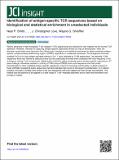Identification of antigen-specific TCR sequences based on biological and statistical enrichment in unselected individuals
Author(s)
Smith, Neal P; Ruiter, Bert; Virkud, Yamini V; Tu, Ang A; Monian, Brinda; Moon, James J; Love, J Christopher; Shreffler, Wayne G; ... Show more Show less
DownloadPublished version (1.418Mb)
Publisher with Creative Commons License
Publisher with Creative Commons License
Creative Commons Attribution
Terms of use
Metadata
Show full item recordAbstract
Recent advances in high-throughput T cell receptor (TCR) sequencing have allowed for new insights into the human TCR repertoire. However, methods for capturing antigen-specific repertoires remain an area of development. Here, we describe a potentially novel approach that utilizes both a biological and statistical enrichment to define putatively antigen-specific complementarity-determining region 3 (CDR3) repertoires in unselected individuals. The biological enrichment entailed FACS of in vitro antigen-activated memory CD4+ T cells, followed by TCRβ sequencing. The resulting TCRβ sequences were then filtered by selecting those that are statistically enriched when compared with their frequency in the autologous resting T cell compartment. Applying this method to define putatively peanut protein-specific repertoires in 27 peanut-allergic individuals resulted in a library of 7345 unique CDR3β amino acid sequences that had similar characteristics to other validated antigen-specific repertoires in terms of homology and diversity. In-depth analysis of these CDR3βs revealed 36 public sequences that demonstrated high levels of convergent recombination. In a network analysis, the public CDR3βs were shown to be core sequences with more edges than their private counterparts. This method has the potential to be applied to a wide range of T cell-mediated disorders and to yield new biomarkers and biological insights.
Date issued
2021Department
Massachusetts Institute of Technology. Department of PhysicsJournal
JCI Insight
Publisher
American Society for Clinical Investigation